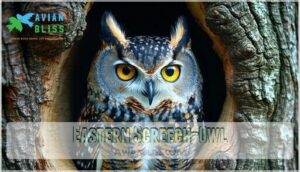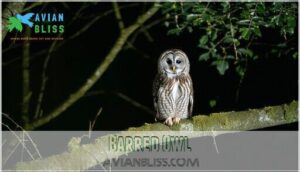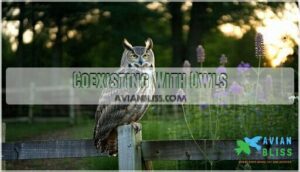This site is supported by our readers. We may earn a commission, at no cost to you, if you purchase through links.

The Eastern Screech-Owl’s horse-like whinny echoes from backyard trees, while Great Horned Owls deliver their classic "hoo-hoo-hoo" from tall oaks.
Barn Owls glide silently over fields with heart-shaped faces, and Barred Owls call "who-cooks-for-you" from wooded areas.
Short-eared Owls hunt grasslands during twilight hours.
These nocturnal hunters have adapted perfectly to Alabama’s diverse habitats, from urban parks to rural farmland.
Each species brings unique hunting techniques and remarkable adaptations that make spotting them an unforgettable experience once you know their secrets.
These adaptations make Alabama’s owls a fascinating group to explore, with their ability to thrive in various environments being a key aspect of their survival.
Table Of Contents
- Key Takeaways
- Owl Species in Alabama
- Alabama Owl Habitats
- Owl Hunting Techniques
- Alabama Owl Conservation
- Coexisting With Owls
- Frequently Asked Questions (FAQs)
- What is the most common owl in Alabama?
- Is it good to have owls in your yard?
- Can an owl pick up a 10 lb cat?
- Are owls good to have in your yard?
- Why is an owl always in my yard?
- What time of day are owls active?
- How do owls maintain silent flight?
- What adaptations allow owls to hunt at night?
- Why are owl neck rotations beneficial?
- What is the purpose of owl pellets?
- Conclusion
Key Takeaways
- You’ll find five owl species in Alabama – Eastern Screech-Owls, Great Horned Owls, Barn Owls, Barred Owls, and Short-eared Owls – each with distinct calls and hunting techniques that make identification straightforward once you know their secrets.
- You can spot these nocturnal hunters in diverse habitats from your backyard to rural farmland, with Great Horned Owls being the most common and Eastern Screech-Owls thriving in suburban neighborhoods.
- You’ll benefit from having owls in your yard since they’re natural pest controllers that eat rodents, mice, and rats without posing threats to people or larger pets.
- You can support owl conservation by reducing pesticide use, maintaining mature trees, minimizing outdoor lighting, and creating wildlife-friendly spaces on your property.
Owl Species in Alabama
You’ll discover five remarkable owl species that call Alabama home, each with unique hunting styles and habitat preferences.
These nocturnal hunters range from the tiny Eastern Screech-Owl to the powerful Great Horned Owl, making Alabama backyards prime real estate for owl watching adventures.
Eastern Screech-Owl
You’ll recognize Alabama’s most common owl species by its distinctive trill echoing through suburban neighborhoods.
Listen closely on quiet Alabama evenings—that haunting trill might be your neighborhood’s tiniest owl hunter.
These pint-sized predators show remarkable urban adaptation, thriving in backyard habitats from Birmingham to Mobile. Color morphs range from gray to reddish-brown, helping screech owls blend seamlessly into tree bark for perfect camouflage.
Key Eastern Screech-Owl Features:
- Vocalizations – Haunting trills and whinnies, not actual screeches
- Nesting Habits – Cavity nesters using old woodpecker holes in mature trees
- Size – Compact 6-10 inch body with prominent ear tufts
- Hunting Style – Silent swooping on insects, small mammals, and amphibians
Great Horned Owl
You’ll recognize the great horned owl by its distinctive ear tufts and piercing yellow eyes.
These Alabama owls are fierce predators, standing nearly two feet tall with powerful talons that can crush prey.
Their deep "hoo-hoo-hoo" calls echo through Alabama wildlife areas at dusk.
Great horned owls adapt to various owl habitats, from forests to suburban neighborhoods, making them the most widespread owl species in the state.
American Barn Owl
You’ll recognize the American Barn Owl by its heart-shaped white facial disc and silent flight across Alabama fields.
These Alabama owls nest in barns, silos, and tree cavities, producing distinctive screeching calls rather than hoots.
Their exceptional hearing helps them hunt rodents in complete darkness.
Conservation efforts protect their habitat as barn owl populations face modern agricultural challenges throughout Alabama wildlife areas.
They’re nocturnal hunters, achieving peak activity between dusk and dawn.
Barred Owl
You’ll easily recognize barred owls by their distinctive "who-cooks-for-you" calls echoing through Alabama’s forests.
These adaptable birds nest in tree cavities, with juveniles showing different plumage patterns than adults.
Regional variations exist across Alabama, though hybridization risks remain minimal.
Their varied owl sounds make barred owl identification straightforward for Alabama birds enthusiasts exploring diverse owl habitats.
Short-eared Owl
Short-eared owls rarely visit Alabama, making each sighting special for Alabama birds enthusiasts.
Unlike other Alabama owls, these medium-sized birds of prey prefer open field habitat over forests.
Their diurnal activity sets them apart – you might spot one hunting during daylight hours.
These nomadic owls show irruptive behavior, appearing unpredictably based on prey availability.
Their ground nesting habits and declining conservation status make Alabama bird sightings particularly remarkable for researchers tracking owl identification patterns.
Alabama Owl Habitats
You’ll find Alabama’s owls in three main habitat types that offer distinct advantages for hunting and nesting.
These diverse environments across the state support different owl species, from dense forests where Barred Owls call to open grasslands where Short-eared Owls patrol for rodents.
Forests and Woodlands
Deep within Alabama’s forests and woodlands, you’ll discover Forest Owls like Great Horned and Barred owls mastering Camouflage Techniques among oak and pine trees.
Their Nesting Habits include hollow trees and dense canopies, while Woodland Sounds echo through preserved areas supporting Forest Conservation.
These owl sightings showcase Alabama’s rich wildlife, making bird sightings rewarding for owl conservation enthusiasts exploring diverse habitats, which is crucial for Forest Conservation.
Grasslands and Wetlands
Open grasslands and wetland areas provide critical hunting grounds for Alabama’s Wetland Owls, particularly Short-eared Owls.
These habitats offer exceptional Prey Abundance through diverse rodent populations and ideal visibility for aerial hunting.
However, Habitat Loss threatens owl ecology as development reduces Grassland Conservation efforts. Protecting native grasslands is essential for these species.
Water Quality in wetlands directly impacts wildlife habitat by supporting the food webs these owls depend upon for survival success.
Urban and Residential Areas
You’ll find Urban Owls thriving in parks, golf courses, and tree-lined neighborhoods throughout Alabama cities.
These adaptable hunters benefit from reduced competition and abundant prey like rats and mice.
However, Light Pollution disrupts their natural hunting patterns, while Human Interaction poses risks through vehicle strikes.
Creating owl-friendly Residential Habitats means preserving mature trees, reducing outdoor lighting, and maintaining wildlife corridors for successful owl conservation efforts.
Owl Hunting Techniques
You’ll witness Alabama’s owls employing remarkably diverse hunting strategies that change based on prey size, habitat, and time of day.
From the silent swooping techniques of Great Horned Owls targeting rabbits to the precise ground-hunting methods of Short-eared Owls catching voles, each species has evolved specialized approaches that make them incredibly effective nighttime predators.
Prey Preferences
Alabama owls aren’t picky eaters, but they definitely have favorites.
These skilled hunters adapt their owl diet based on what’s available in their territory. Small rodents make up the bulk of most species’ meals, though seasonal prey shifts keep things interesting.
Here’s what you’ll find on an Alabama owl’s dinner menu:
- Small rodents – mice, rats, and voles dominate rodent consumption patterns
- Birds – smaller songbirds fall victim to bird predation, especially during nesting season
- Insects – beetles, moths, and crickets supplement insect diets for smaller owl species
- Amphibians – frogs and salamanders provide protein-rich owl food sources near water
- Fish – some species snatch fish from shallow streams, boosting hunting success rates
Rodent prey remains the cornerstone of most Alabama owl hunting strategies, with each species showing preferences based on their size and habitat.
Hunting Strategies
Alabama’s owls employ sophisticated hunting strategies that make them formidable nocturnal predators.
Through precise prey detection using asymmetrical ear placement, these birds locate mice rustling beneath leaves from remarkable distances.
Their silent flight, achieved through specialized feather structures, allows stealthy approaches.
Seasonal changes affect hunting patterns as prey availability shifts throughout the year.
Owls, however, aren’t immune to predation and employ various bird predator avoidance.
| Hunting Strategy | Description |
|---|---|
| Silent Approach | Specialized wing feathers muffle sound during flight |
| Precise Strikes | Sharp talons deliver swift, lethal attacks |
| Patient Perching | Owls wait motionlessly for prey movement |
| Territory Patrol | Regular hunting routes maximize success rates |
Nocturnal and Diurnal Hunting
Most Alabama owls are nocturnal birds, but you’ll occasionally catch them hunting during daylight hours.
Their remarkable sensory perception gives them hunting success in both scenarios, with seasonal variations affecting their prey capture timing.
Here’s how Alabama’s owl behavior adapts:
- Nocturnal hunting – Great Horned and Barred Owls use silent flight and exceptional hearing to locate prey in complete darkness
- Diurnal hunting – Short-eared Owls actively hunt during dawn and dusk, especially in winter months when prey is scarce
- Weather adaptations – These bird predators adjust their hunting schedules based on moon phases and weather conditions for ideal hunting adaptations
Alabama Owl Conservation
You’ll find that Alabama’s owls face real challenges from habitat loss, light pollution, and pesticide use that threaten their populations across the state.
Conservation efforts focus on protecting nesting sites, monitoring population trends, and educating landowners about creating owl-friendly environments on their property.
Threats to Owl Populations
Alabama’s owls face mounting challenges from habitat loss, pesticide use, and vehicle collisions.
Deforestation and urban development destroy nesting sites, while anticoagulant rodenticides poison over half of tested owls through contaminated prey.
Climate change alters prey availability, creating scarcity issues.
Highway strikes kill many owls during hunting flights, contributing to owl population decline across the state.
Providing owl nesting boxes can help offset the loss of natural nesting sites, addressing the issue of nesting sites.
Habitat Preservation
Conservation groups protect owl habitat across Alabama through targeted initiatives.
The Nature Conservancy has preserved over 18,000 acres of essential wetlands and bottomland forests.
Wetland Conservation and Forest Management programs restore converted habitats, while Grassland Protection efforts counter Urban Sprawl and Habitat Fragmentation.
The state’s wetland restoration efforts are vital, as approximately 50% of Alabama’s natural wetlands have been converted.
You can support owl habitat preservation by reducing pesticide use and maintaining wild spaces on your property.
Research and Monitoring
Scientists use several methods to track owl populations across Alabama. Acoustic monitoring with automated recording units captures calls more accurately than traditional field surveys, while call-broadcast techniques help researchers identify specific species and locations.
- Owl tracking technology includes GPS tags and radio telemetry for movement studies
- Population studies rely on standardized protocols across different habitat types
- Habitat analysis examines forest cover, grasslands, and urban areas for owl density
- Conservation impact assessments guide land management and restoration decisions
Coexisting With Owls
You’ll discover that sharing your Alabama backyard with owls creates a fascinating natural partnership that benefits both species.
Learning proper observation techniques and understanding owl behavior helps you appreciate these nocturnal neighbors while keeping them safe and undisturbed, which is crucial for a harmonious partnership.
Owl Watching Tips
Start your owl watching adventure with the right gear. Best Binoculars help you spot details from a distance, while Night Vision equipment reveals nocturnal activity.
Consider using specialized viewing equipment to enhance your viewing experience. Practice Respectful Viewing by staying quiet and maintaining distance.
Learn common Owl Calls to identify species without seeing them. For Ethical Photography, avoid flash and excessive noise.
These birdwatching tips enhance your bird identification skills while respecting owl behavior.
Residential Area Considerations
Living near owls means understanding owl proximity affects your daily routine.
These nocturnal neighbors require specific considerations for peaceful coexistence in residential areas.
Here are three key considerations for owl-friendly neighborhoods:
- Pet safety protocols – Keep small dogs and cats indoors during peak owl hunting hours (dusk to dawn)
- Noise levels management – Reduce outdoor lighting and loud sounds that disrupt owl behavior patterns
- Nesting sites protection – Preserve mature trees and avoid disturbing potential owl territory during breeding season
Understanding owl habitat preferences helps you anticipate their presence.
For added security, consider investing in enhanced visibility options for your pets.
Light pollution disrupts their natural hunting cycles, while wildlife observation from a respectful distance supports healthy owl behavior observations.
Cultural Significance of Owls
Owls carry deep cultural meaning across Alabama’s communities.
Native American tribes like the Cherokee and Choctaw viewed these birds as spiritual messengers, while owl symbolism appears throughout Southern folklore.
Modern interpretations blend traditional beliefs with scientific understanding of owl behavior patterns.
| Cultural Group | Owl Symbolism | Belief | Species Focus | Modern View |
|---|---|---|---|---|
| Cherokee Tribe | Death messenger | Shape-shifting witches | Great Horned Owl | Spiritual guidance |
| Choctaw Nation | Soul bearer | Guardian spirits | Screech Owl | Cultural heritage |
| African American | Death bird | Fatal omens | Eastern Screech | Educational symbols |
| Southern Folklore | Supernatural agent | Night warnings | Barn Owl | Literature references |
| Contemporary | Wisdom keeper | Nature connection | All species | Conservation icons |
These folklore influences shaped how Alabamians view owl characteristics today, creating rich owl diversity in cultural storytelling alongside scientific owl species identification and owl behavior observations.
Frequently Asked Questions (FAQs)
What is the most common owl in Alabama?
Like a gentle giant patrolling night’s quiet forests, the great horned owl is the largest and probably most common owl species in Alabama.
You’ll spot them easily with their distinctive ear tufts and rusty-orange eye feathers.
Is it good to have owls in your yard?
Having owls in your yard is beneficial because they’re natural pest controllers, eating rodents that damage gardens and spread disease.
They won’t harm pets or people, making them excellent neighbors for your property.
Can an owl pick up a 10 lb cat?
Your feathered neighbor might struggle to "borrow" your cat permanently.
Large owls like Great Horned Owls can lift about 3-4 pounds maximum, making your 10-pound feline too heavy for aerial kidnapping adventures.
Are owls good to have in your yard?
Having beneficial predators in your backyard can be incredibly valuable.
You’ll find they naturally control rodent populations, reducing mice, rats, and voles that damage gardens and property while maintaining ecological balance effectively.
They are incredibly valuable in this role, and their presence can greatly benefit your backyard ecosystem.
Why is an owl always in my yard?
A silent sentinel stands watch over your territory—nature’s appointed guardian has chosen your yard as its hunting headquarters.
You’ve got abundant prey like mice, rats, or insects that draw this nocturnal hunter nightly to feast.
What time of day are owls active?
Most owls are nocturnal, becoming active at dusk and hunting throughout the night.
However, you’ll find snowy owls are more diurnal, hunting during daylight hours due to their Arctic origins where summer brings continuous sunlight.
How do owls maintain silent flight?
You’ll discover that owls achieve silent flight through specialized feather adaptations.
Their wing feathers have soft, fringed edges that break up air turbulence, while downy surfaces muffle sound, letting them approach prey undetected with their unique ability to achieve undetected approaches.
What adaptations allow owls to hunt at night?
You’ll find that owls possess remarkable night-hunting adaptations.
These include large eyes that gather maximum light, asymmetrical ear openings for precise sound location, and specialized feathers enabling silent flight to surprise prey.
Why are owl neck rotations beneficial?
You’ll turn your head up to 270 degrees because your eyes can’t move in their sockets.
This incredible neck flexibility lets you track prey and scan for threats without moving your body, keeping you perfectly camouflaged while hunting.
What is the purpose of owl pellets?
You’ll find owl pellets contain undigested bones, fur, and feathers that owls can’t break down.
They regurgitate these compact masses to clear their digestive system, making pellets valuable for studying their diet and prey.
Conclusion
Remarkably, you’ve probably heard these owls in Alabama without realizing it.
That mysterious nighttime hooting comes from one of five species thriving in your area.
Eastern Screech-Owls, Great Horned Owls, Barn Owls, Barred Owls, and Short-eared Owls each bring unique hunting skills to Alabama’s landscapes.
You’ll find them adapting to urban parks, woodlands, and grasslands with remarkable success.
Their nocturnal presence enriches Alabama’s ecosystem while offering you incredible wildlife viewing opportunities right outside your door.














